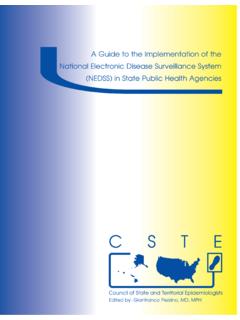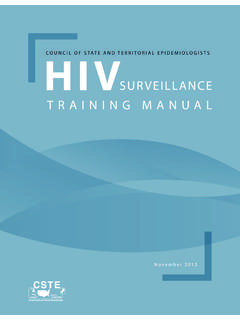Transcription of Assessment of State Activities in Non-Infectious ...
1 Assessment of State Activities in Non-Infectious environmental health exposure monitoring and InvestigationJUNE 2015 COUNCIL OF State AND TERRITORIAL EPIDEMIOLOGISTSPage 2 of 81 Acknowledgements The Council of State and Territorial Epidemiologists (CSTE) would like to acknowledge the dedication of the working group of CSTE members that developed the Sentinel Assessment and subsequent recommendations provided within this document. Additionally, the working group would like to acknowledge the contribution of Kristina W. Kintziger, PhD, Florida Department of health , for data analysis and authorship of this publication. This publication was supported by Cooperative Agreement Number 1U38OT000143 from CDC. Its contents are solely the responsibility of the authors and do not necessarily represent the official views of CDC.
2 Authors (in alphabetical order) Henry Anderson, MD, Wisconsin Department of health Services Kristina W. Kintziger, PhD, Florida Department of health Erin Simms, MPH, (Former) Council of State and Territorial Epidemiologists Martha Stanbury, MSPH, Michigan Department of Community health Sharon M. Watkins, PhD, Florida Department of health Jessica Wurster, MPH, Council of State and Territorial Epidemiologists Page 3 of 81 Table of Contents List of Tables and Figures 4 Executive Summary 5 Introduction 8 Methods 9 Assessment Development and Administration 9 Definitions 10 Impact Measure of health Effects and exposure Events on environmental health Activities 10 Data Cleaning and Statistical Analysis 11 Results 12 Environment-Related health Conditions 12 environmental exposure Events 19 Syndromic Surveillance as a Tool for environmental monitoring and Response 25 Effect of Radiation Control Agency Location on Radiation exposure Event Reporting and Activities 25 Resources and Barriers to monitoring and Response 27 Discussion 32 Recommendations 34 Appendix A Assessment Tool 35 Appendix B Summaries
3 By health Condition 60 Appendix C Summaries by exposure Event 72 Page 4 of 81 List of Tables and Figures Tables Table 1. Ranking System: Number of Cases Reported Annually Table 2. Ranking System: Population Size Based on US Census 2010 Estimates Table 3. Reporting of Environment-Related health Conditions Table 4. Sources for Identification of Persons with health Conditions of Interest Table 5. Procedures for Follow-up of Individual Case Reports Table 6. Estimated Number of Cases Reported Annually that Meet Case Definition or Are Considered a Case by Agency and Percent that Trigger an investigation Table 7. Differences in Reportable health Conditions between the State Reportable Conditions Assessment and this environmental health Assessment Table 8. Reporting of environmental exposure Events Table 9. Sources for Identification of environmental exposure Events Table 10.
4 Procedures for Follow-up of environmental exposure Events Table 11. Estimated Number of environmental exposure Events Reported Annually and Triggering Follow-up Table 12. Location of Radiation Agency by Radiation Event Reporting and Activities Table 13. Percentage of Environment-Related health Conditions Triggering investigation among States with environmental Public health Tracking Funding Table 14. Percentage of Environment-Related health Conditions Triggering investigation among States with National Institute for Occupational Safety and health Funding Table 15. Full-Time Equivalent Employees Devoted to Environment-Related Activities by Funding Source Table 16. Barriers to monitoring and Response of Environment-Related health Conditions and exposure Events Figures Figure 1. Percentage of Total Impact of Activities and Reporting for Environment-Related health Outcomes Figure 2.
5 Percentage of Total Impact of Activities and Reporting for environmental exposure Events Page 5 of 81 Executive Summary During December 2013 March 2014, the Council of State and Territorial Epidemiologists with the National Center for environmental health at the Centers for Disease Control and Prevention assessed State and several large local health departments to describe current processes for and experiences with the monitoring and investigation of environmental exposures and associated acute health effects. The results of this Assessment demonstrate environmental health -related Activities that are being successfully implemented in many health departments and can be used to build environmental health investigation and response capacity nationwide. Results Forty-five ( ) of 56 agencies completed the Assessment .
6 1. Environment-Related health Conditions Note: Eleven environment-related health conditions were assessed including lead toxicity in children, lead toxicity in adults, mercury toxicity, arsenic toxicity, cadmium toxicity, acute pesticide illness/injury, acute respiratory disease related to chemical exposure ( , chemical pneumonitis, acute asthma exacerbation), acute disease cluster possibly linked to an environmental exposure , methemoglobinemia, carbon monoxide poisoning, and hyperthermia morbidity and mortality. Agencies indicated that they collect data on a variety of health conditions, even if the condition is not legally reportable within the jurisdiction ( , heat-related morbidity and mortality data are collected by 33% but legally reportable in only 7% of jurisdictions).
7 Jurisdictions varied widely by which conditions they monitored. For example, almost all responding jurisdictions indicated that they collect data on child lead toxicity (96%) while only 22 percent monitored for methemoglobinemia. For 6 of the 11 conditions of interest, <50% of respondents indicated that case report data for these conditions are summarized and made public each year. For all health conditions, <36% of respondents reported summarizing and making follow-up exposure investigation results publicly available. Reporting sources and follow-up procedures varied, although physician and laboratory reporting, case-patient interview, and exposure investigation were most common. o Poison control reporting (56%) was common for acute pesticide illness, while phone calls from citizens (51%) were common for acute disease clusters.
8 O Medical record reviews were frequently used for acute respiratory disease (55%), acute disease clusters (52%), and methemoglobinemia (60%). Lead toxicity for children and adults had the greatest impact on environmental health Activities in terms of case numbers reported annually and weighted by population size; >50% of respondents receive 100 reports annually for these conditions. Although few cases were reported annually, methemoglobinemia and acute disease clusters triggered investigations most commonly, with over 50% of cases investigated. 2. environmental exposure Events Note: Nine environmental exposure events were assessed including mold, radiation releases or exposures, chemically contaminated products, chemically contaminated food, chemically contaminated water, mercury spills, carbon monoxide releases, pesticides misapplications or accidental exposures, and other chemical spills or releases.
9 Chemical contamination of water (80%) and food (73%) and mold-related events (76%) were the most common exposures for which responding agencies collected data. Page 6 of 81 exposure event data were infrequently summarized and made public across all types of events; the most common exposure events summarized were carbon monoxide releases (41%) and chemical contamination of water (39%). Phone calls from citizens or referrals from external agencies were common sources of event reports, and referrals to appropriate regulatory agencies and technical assistance or telephone consultation were common follow-up procedures used. o Epidemiologic investigations occurred most frequently for chemically contaminated food (73%), and site visits were most common for radiation releases or exposures (71%) and chemically contaminated food (70%).
10 Mold exposure events had the greatest impact on environmental health Activities in terms of the number of events reported annually and weighted by population size; 62% of respondents receive 100 case reports annually for mold exposures. Although few events are reported annually, chemical contamination of water and food trigger exposure investigations most commonly, with about 80% of events investigated. 3. Syndromic Surveillance as a Tool for environmental monitoring and Response More than half (24 [ ]) of respondents reported not using syndromic surveillance for any of the 11 health conditions of interest. Ten (22%) agencies reported using syndromic surveillance for only1 health condition, and 11 (24%) agencies use it for >1 condition. 4. Effect of Radiation Control Agency Location on Radiation Event Reporting and Activities Fifty-seven percent of responding jurisdictions reported having their radiation control agency within the health department.






